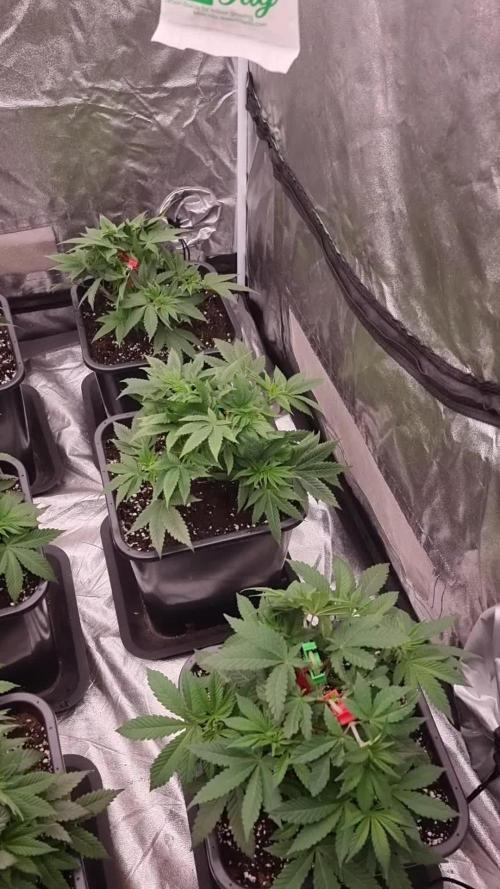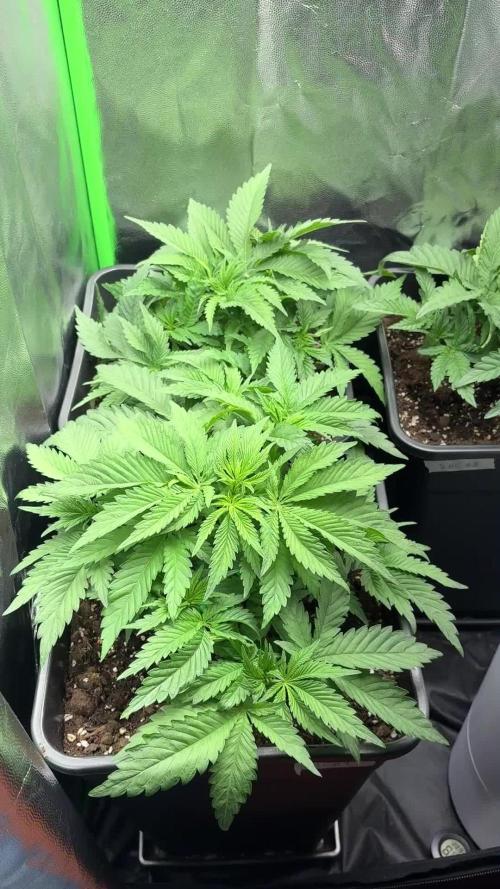The Grow Awards 2026 🏆 

































Likes
Comments
Share


@Dictator
Follow
I need to dry the buds in the dark at 20 degrees in 50% humidity, then transfer them to jars and continue curing 💨
Likes
16
Share


@JJs_Js
Follow
Fun week- buds started packing on mass and frost. just watering til chop day, except for the green crack which is about halfway through flower.
Processing
Likes
82
Share


@ClubRiot
Follow
Start week 5 , Bio Grow 2 ml/L + Sensi Cal-Mag Xtra 2 ml/L + Alg-A-Mic 2 ml/L + CarboLoad 2 ml/L + Bio-Heaven 2 ml/L + Bio-Bloom 1 ml/L ( Ph 6.5).
Likes
5
Share


@Pblc_10
Follow
Das wird die letzte Vegi Woche sein ich denke mal in 2-3 Tagen schicke ich sie in die blüte. Heute habe ich nochmal ein wenig entlaubt und 2 CO² Bags rein gehangen. Sonst sehen sie sehr vital aus und freuen mich schon auf die blüte
Das nächste mal werde ich erst in eine Woche düngen da sie ja erst in den Allmix gepflanzt wurden und alles noch satt grün ist👍
Über Tipps würde ich mich natürlich freuen🍀✌️
Likes
12
Share


@Dankybongtoker69
Follow
Didn't have someone to come water the plants. 5 days away. Plants dried right out. Defoliated both and fed and watered. We will see what happens. Plant one has mostly orange hairs. Plant two is on the whiter side. Buds are still filling in. I have definitely learned that I need to move on to a more automated system for my lifestyle. Gonna try to make the best of the next few weeks and watch the trichomes turn. Day 66-67 flushed soil with pH water
Likes
18
Share


@CanarianGrow92
Follow
Week 7 for the Caramel 🍯 from Ganja farmers 👨🌾
Awesome results for now, the buds are looking great and getting bigger every week, more and more trichomes are visible.
Not much left so we continue with water for now.
A slight excess of nutrients is visible but nothing to worry about as we are flushing now anyway
Likes
72
Share


@BodyByVio
Follow
Day 9 I had no choice but to defoliate, the canopy was getting way to dense and humidity was hard to control even with my 30 pin dehumidifier. Hopefully will not affect to much. Probably I will do another defoliation on day 21.
TDS stays at 550PPM this week and CO2 at 1200PPM.
Likes
2
Share


@Popsgrow
Follow
Just watered her with 1.25 gallons of ro water with 1teaspoon each of build a bloom and coconut powder and big six
Likes
2
Share


@jardinprimitivo
Follow
El sabado 7 arranca una nueva semana de vegetativo, las plantas crecen con vigor, la Ztrawberry esta mas bajita que las Full Gas.
Se esta regando solo con 2 litros de agua con ph 6.3 dia por medio solamente para mantener la humedad.
10/9 Se aplica poda apical a todas las puntas y se retiran hojas que tapen la luz.
Likes
12
Share


@cookingwithninja
Follow
best cannabis I ever grew and smoked. Others agree. This is a cup winner I would win with no competition. 3 months harvested, 90% consumed. Will run more genetics and future cross, backcross. Feels like energy drinks, positive, 100% youre high and lit, extreme ripped. Smell is slight citrus, this is very sweet tasting and smelling because of my methods of growing. Oozing sticky like an industrial adhesive. Daytime smoke, ripped no couchlock. For heavy daily smoker this is above your level of comprehension, good luck finishing 0.5g session. 10/10 all categories.
4 months after harvest video macro, this is what 40% looks like
Likes
20
Share


@Nenay
Follow
Accidently added week 3 too early. I'll wait a little longer to add the 4th week to even it out.
The plants are doing somewhat good but not great. The yellow one is restoring to a fuller green. It seems they all have a little heat stress though and they're not growing as fast as I'd like. If I compare it to my window grow, where my Fast Eddy CBD is just as old as the plants of my outdoor grow. Then Fast Eddy is a lot further. I think they're a bit stunted by the cold in the first week and a half and now it's quite hot for them.
Will have to be patient to see how they recover.
8/6 Great growth :D especially on the companion plants. Too bad my plants seem to have some bug problems. I think it's leafhoppers. Especially the 2 x critical CBD are affected, but the sweet CBD that was more lightgreen also seems to be affected.
Processing
Likes
21
Share


@Siriuz
Follow
Starting week 10
Day 77
Ladie is getting some nutes plus water
Day 78
Whoa she's growing a lot
Day 79
Gonna start scrog soon
Day 80
Root its thriving like crazy, uploaded new video, check it out!
Day 81
Time to feed the lady again plus added more ffof soil with perlite and clay peebles
Day 82
All good, no nutrient burnt @ 1810ppm
Day 83
Had to expand the net, added scrog plus some other features, she's a monster it's Giving me a lot of work to do but I'm really happy with this huge lady growing up!!
End of week 10 with some videos to show progress!
Likes
9
Share


@bigolebuds
Follow
Week 5 (11/30 - 12/6): Things are getting excitingggggggg!! I had to get some gloves because the buds are getting sticky -icky -ickyyyyy. I mean over these two weeks you wouldn't even recognize this tent. The flowers have really packed on some size and the smell is increasing by the day. It feels like we are coasting and just need to keep things watered at this point, but we have our lights up as high as they can go, so we are hoping we don't get too much more of a stretch from the plants. Next week will be our last topdress for these plants with our Gaia Green 2-8-4, and from there we will have about 4/6 more waterings with our terp tea and we will be just about done with our feeding schedule.
We are considering another layer of trellis, and we had to upgrade our PH pen AGAIN.. so to all new growers, don't waist the money, get the Blue Lab from the start and take good care of it. We learned our lesson with $20. Otherwise, I don't have much to say other than stand by for some big ole harvests coming your way.
Check out our before and after pics!
Likes
2
Share


@Hidden
Follow
:
- Day 1 week 5: just checking how lst is doing, they will be ok
- Day 2 week 5: not completely dry to water so I’ll wait for day 3 of week. Did lst to make sure all branches receive as much ligth as possible
- Day 3 week 5: watered them with 4ml/L calmag and 2ml/L bio grow ph 6,5 tap water trough activated carbon filter. RHC#2 broke one of the branches, I had to tape it. Not to be worried, she’ll recover from that. RHC#3 is very slow compared to the others.
- Day 4 week 5: defoliation so sun enters better
Likes
17
Share


@JonnyKush
Follow
hey guys sorry for the absence but in this period I have had a lot to do with my work and I have not been able to bring a good detailed diary, but finally now the holidays will start and I will be able to dedicate myself 110% to a new crop and new ones diaries. having said that, I think I will leave him a week at the most and finally reap the benefits 💚🌳💚🌳maybe my fault the RQS slow release nutrients did not perform as much as the ADVs in my tent, you can see it from the video of 27/07/22 where you can see that 2 out of 6 plants are visually leaner and less compact to the touch , I wanted to try on the same varieties in order to have feedback. I think it could also be caused by the crowding of the tent but with the ADV I have not encountered any problems. I will definitely try them again, giving them much more attention.
Likes
83
Share


@420DeepGrow
Follow
Gracias al equipo de Fast Buds 420 por la donación de las semillas y poder inscribirme en el concurso del año.
Creada a partir de la genética de la Girl Scout Cookies y la Gorilla Glue #4, seleccionadas a mano y en combinación con nuestra famosa Gorilla Cookies Auto, esta variedad lleva todos los mejores atributos de sus padres al más alto nivel. Este híbrido maravillosamente equilibrado prospera en el interior y en el exterior, y en todo tipo de climas, a la vez que es superresistente a los bichos y las plagas. Es una productora masiva que ofrece a los cultivadores de todos los niveles rendimientos de hasta 650 g/m² de cogollos de primera calidad que no decepcionan en absoluto. Siendo una de las versiones más potentes de esta genética, la Gorilla Cookies FF (Fastflowering) presume de un enorme porcentaje de 29 % de THC que se traduce en montones de resina y terps sabrosos que hacen las mejores extracciones. Es la elección perfecta para los cultivadores de hachís que buscan cepas de gran potencia que produzcan sabores y aromas excepcionales.
Consigue aquí tus semillas 😁🌻🚀:
https://2fast4buds.com/es/seeds/gorilla-cookies-fast-flowering
📆 Semana 11 de floración:
Es la planta mas grande y con mas resina de todas las que tengo, esta aceptando muy bien los nutrientes.
Los cogollos comienzan a madurar, empieza el lavado de raices y proximamente cosecha
Likes
11
Share


@adam_pawloski87
Follow
Let’s go day 19 of flower🌺 y’all!!! These girls are doing so amazing, especially the smell for these already , just absolutely lovely! We are heading into week 3 of flower alot of very nice bud spots to build on , these girls are gonna be one of a kind so y’all don’t want to miss them next updates, keep them eyes peeled! Y’all have an amazing productive day and let’s grind the rest of this week out and have an amazing weekend! Peace love an positive vibes to all y’all Cheers 😶🌫️💨💨💨💨💨🤙🏻
























